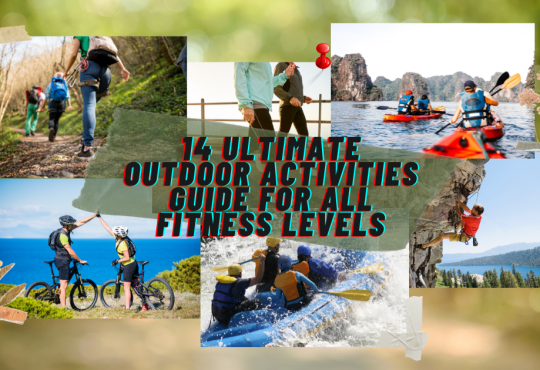Hiking is an exhilarating way to connect with nature, enjoy scenic landscapes, and get some great exercise. Whether you’re a novice or a seasoned hiker, being well-prepared can make all the difference between a memorable experience and a dangerous or uncomfortable one. The right gear, knowledge, and preparation ensure that you stay safe, comfortable, and able to enjoy the adventure. This article will walk you through the essential things for hiking, from proper clothing to the best gear and safety tips for any hiking trip.

Footwear: A Solid Foundation
Your choice of footwear is perhaps the most critical aspect of a successful hike. Improper shoes can lead to blisters, discomfort, and even injury, while the right ones will provide comfort, support, and durability.
Hiking Boots vs. Trail Shoes
- Hiking Boots: For long treks or hikes on rugged, rocky terrain, hiking boots are essential. They offer ankle support, are usually waterproof, and provide better protection against sharp objects like rocks and roots.
- Trail Shoes: These are lighter than hiking boots and better suited for shorter hikes or well-maintained trails. They provide less support but allow for greater agility.
Features to Look for in Hiking Footwear:
- Grip/Traction: A good pair of hiking shoes or boots should have a thick, rugged outsole to prevent slipping.
- Comfort and Fit: Break in your shoes before hitting the trail to avoid blisters and discomfort.
- Waterproofing: Wet feet can cause blisters and general discomfort. Waterproof boots or shoes with Gore-Tex lining are highly recommended for areas prone to rain or water crossings.
Clothing: Dress for the Conditions
Choosing the right clothing is vital for maintaining comfort and safety during a hike. The weather can change rapidly, especially in mountainous regions, so layering is key.
Layering System
The layering system helps regulate body temperature by allowing you to add or remove clothing as needed:
- Base Layer: This is worn next to the skin and is designed to wick moisture away, keeping you dry and warm. Merino wool or synthetic materials like polyester are excellent choices, as they are breathable and quick-drying.
- Mid Layer: The purpose of this layer is insulation. Fleece jackets or insulated vests made from materials like down or synthetic fibers are ideal. They trap heat and keep you warm.
- Outer Layer: This layer protects you from the elements, such as wind and rain. A waterproof jacket with good breathability will shield you from the weather while keeping you dry.
Additional Clothing Tips:
- Socks: Moisture-wicking socks made from wool or synthetic materials help prevent blisters.
- Hats and Gloves: A warm hat and gloves are essential for colder climates. In hot weather, a sun hat can help keep you cool and prevent sunburn.
- Pants vs. Shorts: For rough trails with overgrown vegetation, pants offer more protection. For hot weather and well-maintained trails, shorts might be more comfortable.
Backpack: Carrying Your Essentials
A sturdy, comfortable backpack is essential for hiking, as it allows you to carry all the important gear and supplies you need. Choosing the right one depends on the length of your hike and the type of terrain you’ll be covering.
Features to Consider:
- Size: Daypacks (20-30 liters) are suitable for short hikes, while multi-day backpacks (40-60+ liters) are necessary for longer trips. Make sure your pack can carry all the essential things for hiking, including food, water, clothing, and emergency supplies.
- Fit: Ensure the backpack fits your torso correctly. Most backpacks come with adjustable hip belts and shoulder straps, which help distribute the weight evenly.
- Hydration System: Many modern hiking backpacks come equipped with a built-in hydration system or space for a hydration bladder, allowing for easy access to water without having to stop and unpack.
Navigation Tools: Finding Your Way
Being able to navigate is crucial, especially on less-traveled or unfamiliar trails. Getting lost in the wilderness can be dangerous, so having reliable navigation tools is essential.
Essential Navigation Tools:
- Map and Compass: Always carry a physical topographic map of the area you’re hiking in, along with a compass. Even if you’re familiar with the trail, a map and compass serve as a backup in case your GPS device fails.
- GPS Device: A handheld GPS device or a GPS app on your smartphone can be helpful, but remember that batteries can die, and reception may not always be available. Always have a backup, such as a map and compass.
- Altimeter: This device measures your altitude and can help you pinpoint your location on a topographic map.
- Personal Locator Beacon (PLB): For longer hikes in remote areas, carrying a PLB is highly recommended. These devices send a distress signal via satellite if you’re lost or injured.
Water and Hydration: Staying Hydrated
Proper hydration is critical for maintaining energy levels and preventing heat exhaustion, especially on long hikes or in hot weather. Carrying enough water and knowing where you can replenish your supply are vital.
Water Supply Options:
- Hydration Bladders: These are a great hands-free option, allowing you to drink through a tube without stopping. Many hiking backpacks come with a sleeve to hold a hydration bladder.
- Water Bottles: Reusable water bottles are also a solid choice. Make sure they are lightweight and durable.
- Water Purification: If you’re hiking in remote areas without access to clean water, it’s essential to carry a portable water filtration system or water purification tablets. This allows you to refill your supply from streams or lakes without worrying about contaminants.
How Much Water Should You Carry?
A general rule is to carry at least 2 liters of water for a day hike. However, this amount should be adjusted depending on the climate, intensity of the hike, and the availability of water sources along the trail.
Food and Nutrition: Fuel for Your Adventure
Hiking is a physically demanding activity, and your body will need fuel to keep going. The food you carry should be lightweight, high in energy, and easy to pack.
Essential Food Items for Hiking:
- Trail Mix and Energy Bars: These are lightweight, compact, and provide quick energy.
- Jerky: High in protein, jerky is a great snack that will keep you feeling full for longer.
- Fresh or Dried Fruit: These provide a healthy source of natural sugars for a quick energy boost.
- Nut Butters: Single-serving packets of almond or peanut butter are lightweight and packed with protein and healthy fats.
- Dehydrated Meals: For longer hikes or overnight trips, lightweight dehydrated meals are a convenient option. Just add hot water, and you have a satisfying, calorie-dense meal.
Meal Planning Tips:
- Portion Control: Plan your meals ahead of time to avoid carrying unnecessary weight. Focus on nutrient-dense foods that will keep you full and energized.
- Variety: Don’t rely solely on one type of food. Mix up your snacks and meals to avoid getting bored and to ensure you get a balance of nutrients.
First Aid Kit: Prepared for Emergencies
A well-stocked first aid kit is one of the most important essential things for hiking. Even on short hikes, accidents can happen, and being prepared can help you manage injuries until you can get help.
What to Include in a First Aid Kit:
- Band-Aids and Blister Treatment: Blisters are common on hikes, so include moleskin, blister pads, and band-aids.
- Antiseptic Wipes and Ointment: Clean wounds to prevent infection.
- Bandages and Gauze: For larger cuts and wounds, you’ll need sterile bandages and gauze.
- Tweezers: Useful for removing splinters or ticks.
- Pain Relief Medication: Over-the-counter medications like ibuprofen can help with pain or inflammation.
- Snake Bite Kit: If you’re hiking in areas known for venomous snakes, carry a snake bite kit.
- Emergency Blanket: Lightweight and compact, these blankets can be life-saving in cold or wet conditions.
- Personal Medications: Ensure that you have any personal medications you need, such as inhalers or EpiPens.
Sun Protection: Shielding Yourself from the Elements
Even on cloudy days, UV rays can cause skin damage. Carrying proper sun protection is essential, especially on open trails where shade may be scarce.
Sun Protection Essentials:
- Sunscreen: Use a broad-spectrum sunscreen with an SPF of at least 30. Reapply every two hours or after sweating.
- Sunglasses: Protect your eyes with UV-blocking sunglasses.
- Hat: A wide-brimmed hat can help shield your face, neck, and ears from the sun.
- Lip Balm: Use a lip balm with SPF to protect your lips from getting chapped or sunburned.
Trekking Poles: Support and Stability
Trekking poles may seem unnecessary for short hikes, but they are incredibly useful for longer hikes or rugged terrain. They provide extra stability and help distribute the strain on your legs, knees, and back.
Benefits of Trekking Poles:
- Improved Balance: Poles can help you maintain balance on uneven or slippery terrain.
- Reduced Strain: By using your upper body for support, trekking poles can reduce the strain on your legs, particularly when descending steep trails.
- Stream Crossings: Poles can help stabilize you during water crossings or on rocky, unstable surfaces.
Emergency Tools: Preparing for the Unexpected
Even with the best planning, emergencies can happen. It’s essential to carry a few basic tools that could help you survive if something goes wrong.
Essential Emergency Tools:
- Multi-tool or Knife: A multi-tool or knife is incredibly versatile and can be used for a variety of tasks, from repairing gear to preparing food.
- Fire Starter: Waterproof matches, a lighter, or a fire starter can be life-saving if you need to build a fire for warmth or signaling.
- Whistle: A whistle can be used to signal for help if you’re lost or injured.
- Headlamp: A hands-free light source is critical if you’re hiking in low-light conditions or unexpectedly find yourself still on the trail after dark. Always carry extra batteries.
- Emergency Shelter: If you get caught out overnight or in bad weather, an emergency bivvy or tarp can provide temporary shelter and keep you warm.
Leave No Trace: Respecting Nature
In addition to bringing along all of the essential things for hiking, it’s important to practice the Leave No Trace principle to protect natural environments for future generations. This includes packing out all trash, staying on designated trails, and respecting wildlife.
Leave No Trace Principles:
- Plan Ahead and Prepare: Proper planning helps minimize impact.
- Travel and Camp on Durable Surfaces: Stick to established trails and campsites.
- Dispose of Waste Properly: Pack out all trash, leftover food, and litter.
- Leave What You Find: Leave rocks, plants, and other natural objects as you found them.
- Minimize Campfire Impact: Use a camp stove for cooking, and only build a fire in established fire rings.
- Respect Wildlife: Observe animals from a distance, and never feed them.
- Be Considerate of Others: Share the trail and keep noise levels down.
Hiking is a rewarding and enriching experience, but it’s important to be prepared to ensure your safety and enjoyment. By bringing along the essential things for hiking, including proper clothing, gear, navigation tools, and safety equipment, you’ll be ready for whatever challenges the trail may throw at you. Plan ahead, respect nature, and enjoy the journey—whether it’s a short day hike or a multi-day adventure into the wild.





